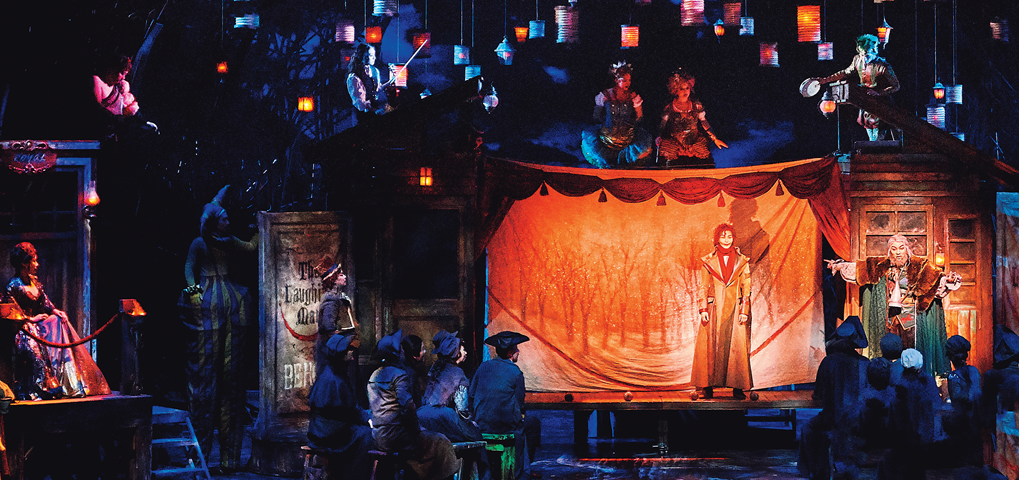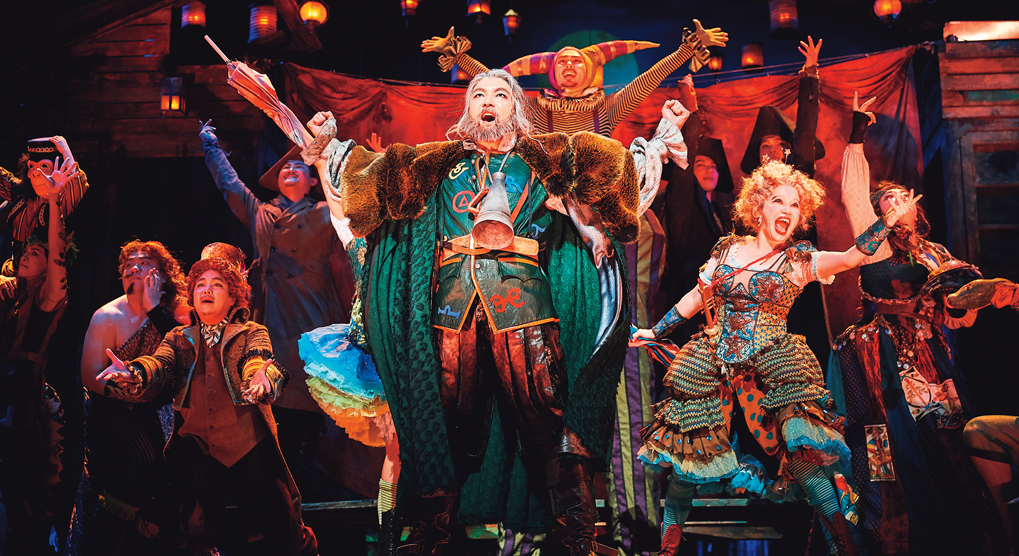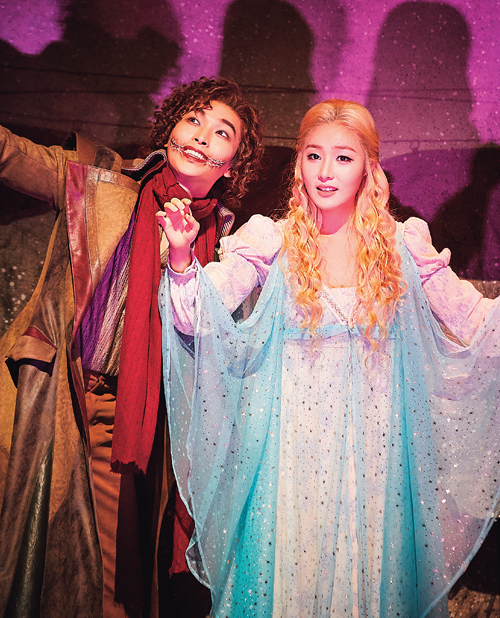The success of a local musical adaptation of Victor Hugo’s novel “The Man Who Laughs” is significant. A seamless collaboration of a star cast and skilled production staff, backed by bold investment, this latest hit on Korea’s thriving musical scene presents new possibilities. It asks whether Korea can grow to be a hotbed of creativity instead of simply importing foreign productions.

A scene from the musical “The Man Who Laughs,” which premiered in July this year to mark the Seoul Arts Center’s 30th anniversary. The musical adaptation of Victor Hugo’s novel by the same name took EMK Musical Company five years to make, with composer Frank Wildhorn and director Robert Johanson on board. The book had been made into a movie in 1928 and 2012, and there is also the 2016 British-made musical “The Grinning Man.”
Musicals are a genre suited for so-called “multiple uses of a single source” The plot is carried through songs and drama performed live on stage, powerfully engaging the audience and bringing the original work back to life. That is why musicals often take for their motif old familiar songs, classic movies, or famous novels and poems. Some prominent examples include “Mamma Mia,” featuring the music of Abba; “The Producers,” adapted from the movie of the same title to initiate a musical comedy boom; and “The Phantom of the Opera” and “Cats,” based respectively on a novel by Gaston Leroux and the poems of T. S. Eliot. These musicals have each given their source material fresh life through theater.
Another Classic is Reborn
“The Man Who Laughs,” which premiered in July at Seoul Arts Center to commemorate its 30th anniversary, is another remarkable musical with a similar background. An avid moviegoer would instantly be reminded by this musical of the 2012 French movie “L’Homme qui rit” directed by Jean-Pierre Ameris and starring Gerard Depardieu, which itself was a remake of a 1928 film by the same title that was based on the novel by Victor Hugo.
“Birth of the Joker from the movie Batman” was the tagline aptly used for the promotion of the latest musical version. It appropriated the Joker from the movie to emphasize the birth of a character whose face was mutilated to wear a permanent grin. The novel is set in 17th-century England, and historical records of the era mention how the nobles disfigured the faces of their servants and mocked them. The novel represents the pathos of ordinary people who had to keep smiling even as they lamented their distorted, unjust society. As such, the novel exposed historical injustice; Hugo said that he could not have written a greater novel than this.

A scene from Act 1 where the actors sing “Step Right Up.” The musical features talented actors deftly portraying the mountebank Ursus and the blind girl Dea, among others.
The musical “The Man Who Laughs” is significant in that it shows both the present and future of the domestic musical industry. EMK Musical Company, which previously produced such hits as “Hamlet,” “Mozart!” and “Elisabeth,” has invested 17.5 billion won and five years in creating this latest work. Most of the company’s previous productions, as illustrated by their titles, were adaptations of foreign works - largely with a European historical background - which had enjoyed commercial success in the Czech Republic, Austria, or Japan, among other countries.
It seems this new approach from the company was based on more than just its business acumen. EMK’s effort to create globally competitive content deserves applause as it taps Korea’s potential to grow as a production base for original musicals, instead of remaining a mere consumer of overseas works. As its script and score have already been exported to Japan on a limited license base, “The Man Who Laughs” is raising expectations for its market potential.

Promotional poster for “The Man Who Laughs.” The lead role of Gwynplaine, whose face was disfigured at an early age, was shared by singer Park Hyo-shin, K-pop group EXO member Suho, and musical actor Park Kang-hyun.
Impressive Stage Craft
Discussion of its industry prospects aside, “The Man Who Laughs” is worthy of praise for its visual spectacle alone. The flawless stage transitions are accentuated by sophisticated visual effects. Korean musicals have matured enough to demonstrate such stunning feats as chandeliers falling and helicopters landing. Truly impressive is the work of the stage designer, who executed many elaborate effects in the previous production, “Mata Hari,” and again enlivens the stage with excitement and imagination.
The hideous smile of the protagonist Gwynplaine appears not only on the actor’s face but on stage curtains and settings as well. And every time the iconic quote, “The paradise of the rich is built on the hell of the poor,” is conveyed in the songs, images or stage settings, the audience is painfully reminded of the cruel irony of the tragedy hidden beneath the splendor of the time. The message still resonates today.
No doubt the cast is one of the production’s great attractions. Singer Park Hyo-shin, Suho from the boy band EXO and musical actor Park Kang-hyun, who take turns playing the role of Gwynplaine, are all huge box office draws. Park Hyo-shin has successfully branched out from pop music to musicals as one of the most bankable stars on the scene. His previous show “The Phantom of the Opera” was a sold-out hit. In “The Man Who Laughs,” Park plays an original character for the first time. As the show ends and the curtain call begins, the enraptured audience erupts, with loud cheers and cries more akin to a packed pop concert.
Suho, the leader of EXO, offers a skillful performance, as expected of a K-pop star who majored in theater at Korea National University of Arts. Park Kang-hyun received wide attention following his appearance on the popular TV audition show “Phantom Singer.” As a professional musical actor, he outshines the other two in terms of theatrical performance. Yet for all of their differences, the three lead actors and those who play Ursus, Dea and other characters exude a wonderful chemistry.
EMK’s effort to create globally competitive content deserves applause as it taps Korea’s potential to grow as a production base for original musicals, instead of remaining a mere consumer of overseas works.

Gwynplaine and Dea sing “Angels in the Tree.” Costume designer Gregory A. Poplyk researched the attire of the times while adding modern touches to bring more color to the individual characters.
Great Teamwork
The production team is also worthy of note. It brings together composer Frank Wildhorn of “Jekyll and Hyde,” “Monte Cristo” and “Scarlet Pimpernel” lyricist Jack Murphy of “Mozart!” and “Rebecca” and director Robert Johanson who is famed for a number of musical masterpieces. Having already worked on numerous productions in Korea, they make a marvelous team, and their collaboration with the local crew also seems to have gone smoothly. Music director Kim Moon-jung, and the lighting, sound and stage designers are all remarkable artists who add their respective prowess to further refine the production.
Victor Hugo’s novels “Les Misérables” and “Notre-Dame de Paris” were already made into musicals that became worldwide hits. Such works are called “novelcals” in Korea. Musicals based on novels have proven to be a formula for success, as seen with “Oliver!,” “A Tale of Two Cities” and “A Christmas Carol” by Charles Dickens, as well as “Jekyll and Hyde,” “Kiss of the Spider Woman,” “Matilda,” “Hamlet” and “Romeo and Juliet.” Of course after watching such musicals, more than a few people are inspired to return to the original works.
Amid the phenomenal growth of the Korean musical industry, “The Man Who Laughs” is drawing keen attention for its potential to break new ground on the world stage. Seeing the impact the production has on the musical market promises to be a show in and of itself.